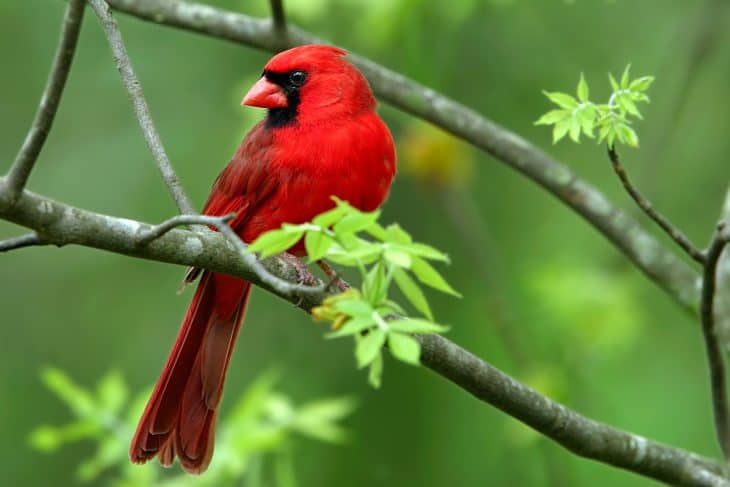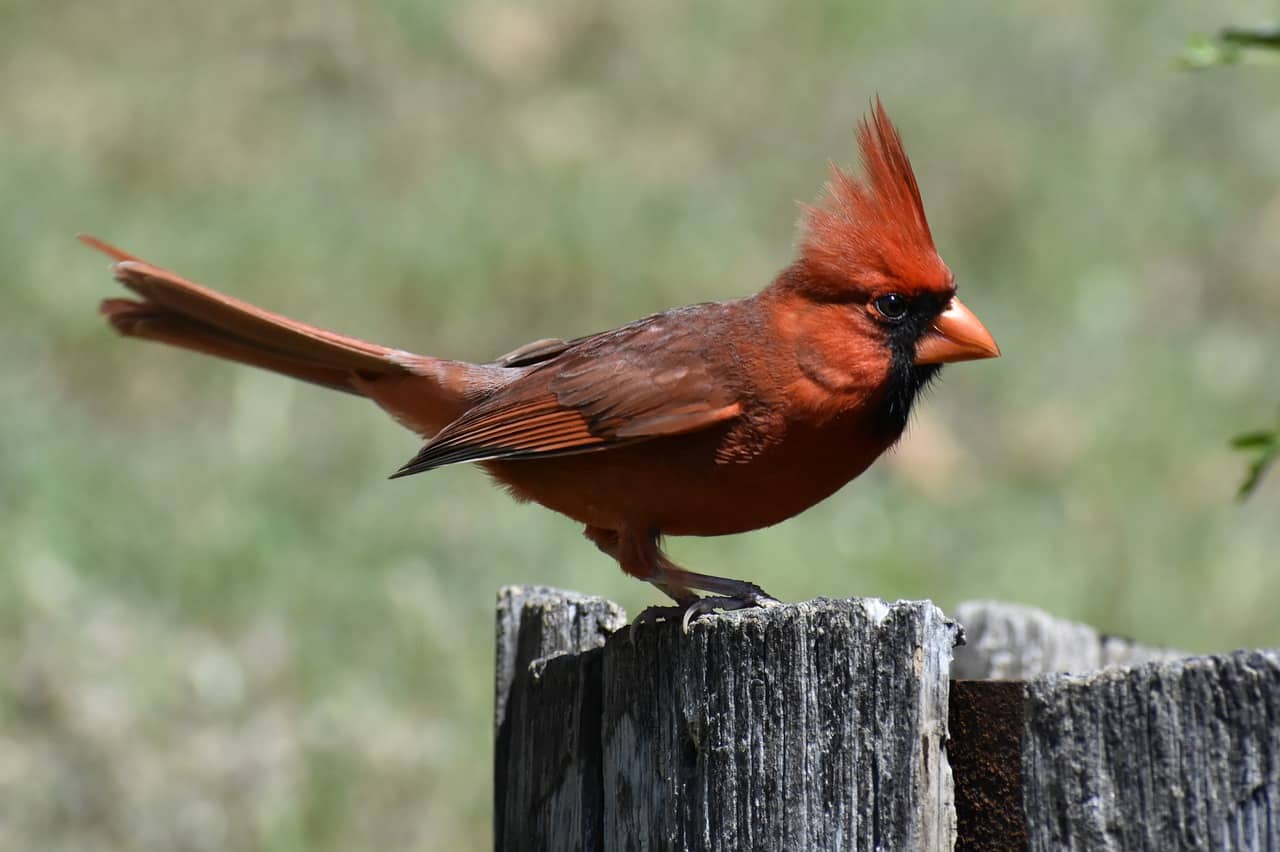
Fall in love with the amazing voice of a Cardinal bird! Each singing session from this bird lasts from two to three seconds. Each song consists of a long series of two-parted whistles that often speed up before ending in a slow trill. Some people say, when you listen closely, you might even hear it sing words that sound like “birdie, birdie, birdie,” or “cheer, cheer, cheer!” One of the most amazing cardinal bird facts out there for sure!
Their awesome capacity to sing is definitely one of the reasons why cardinal birds are one of the most highly preferred backyard birds in North America. This bird can also be found in southern Canada’s swamps, gardens, and woodlands. You will also be able to spot them in southern Mexico’s swamps, gardens, and woodlands. The enchanting and bright colors of this bird’s feathers, and their cone-like beaks make them very easy to spot. They use those beaks to crack seeds.
Have you dreamt of a cardinal bird recently? There are actually many meanings of seeing a cardinal in person, while sleeping, or in a vision. Some people say if you dream or suddenly see a cardinal bird, it means you should reconnect with your spiritual self. This is because the cardinal bird is a spiritual seer and messenger.
Want to know more about this fascinating bird? Read on for more fun and amazing cardinal bird facts!
- A cardinal bird’s size is around 8 to 9 inches or 20 to 22 centimeters.
- There are different types of cardinal birds with more than 15 subspecies.
- The average lifespan of cardinal birds in the wild is 3 years, but some species can live up to 15 years.
- Northern cardinal birds can fly more than 20 miles or 32 kilometers per hour.
- The smallest species of cardinal birds is the orange-breasted bunting which measures 12 centimeters or 4.74 inches.
- Cardinals are passerine birds or active songbirds.
- They commonly live in North and South America.
- Cardinal birds are seed-eating birds.
- Cardinal birds can also eat insects, fruits, grains, and sap.
- The scientific name of the cardinal bird is Cardinalis cardinalis.
- Cardinal birds are also called “red birds” and “cardinal-grosbeak.”
- Male cardinal birds are red in color, except for the black mask on their face.
- Cardinal birds do not migrate, they commonly live in places with warmer climates.
- Female cardinal birds are tan or pale brown with black faces.
- Cardinal birds nest in tangles of vines and shrubs.
- Native Americans believe that seeing a cardinal bird is a sign of a romantic relationship in the future or a renewed courtship and romance.
- In the United States, the cardinal bird is one of the most famous adopted state birds, in fact, seven US states had made them their state bird.
- The name cardinal bird refers to the cardinals of the Roman Catholic Church who wear red robes and caps.
- The cardinal bird is one of the favorite mascots in professional football, baseball, and other athletic games.
- For Native Americans, the cardinal bird symbolizes a loving relationship, courtship, monogamy, and devotion.
Cardinal birds can sing at least 28 songs.
Unlike other bird types that show only males can sing, both male and female cardinal birds can sing at least 28 songs. The two common songs sound like: cheer, cheer, cheer, and pretty, pretty, pretty. A female cardinal sometimes sings on her nest to show that she is hungry and needs food. A male cardinal sometimes sings to keep other males birds away from its partner.

Cardinals can be very aggressive.
Cardinal birds are defensive and can be very aggressive and territorial especially during the breeding season. They sometimes end up attacking glass windows, mirrors, and other reflective surfaces as they perceive their images as intruders.
Crimson-collared grosbeak is a species of cardinal birds.
The Crimson-collared grosbeak is a medium-size, leaf and seed-eating type of cardinal bird. They commonly live in Mexico but during winter, the crimson-collared grosbeak occasionally stays in Rio Grande Valley, Texas. The male crimson-collared grosbeak has black feathers, with red shoulders and belly, while the female has a black head and breast.
Male cardinal birds "continually courts the female."
Cardinals engage in courtship feeding. The male bird offers food to his partner. This occurs more frequently after the actual courtship is done. Male and female cardinals work together building their nests using soft grasses and animal hair. They also both feed and care for their chicks. Cardinal birds mate with their partner during the breeding season.
Cardinal birds lay eggs two to three times a year.
Generally, cardinal birds lay eggs twice or thrice a year. The egg has a whitish-green color and is incubated for 11 to 13 days. A newly hatched baby cardinal has only a few gray feathers; the whole body is naked. Their first set of feathers are brown and develops into black and red as they mature.
The red-crested cardinal is a Brazilian cardinal.
The Paroaria coronata or red-crested cardinal has a white belly, red head, and gray wings. Red-crested cardinal birds are occasionally seen on the eastern coast of the United States, even though they are native to Brazil, Paraguay, Uruguay, and Bolivia. Because of their beauty and melodious songs, it’s not uncommon for people to get them as pets.
Cardinal birds are the first to visit bird feeders and the last to leave.
Cardinal birds are the first to visit bird feeders early in the morning. They are also the last to eat at dusk. A study says that cardinals have this eating routine because their feathers look bright and distinct during daylight, but look black in dim light. Hence, eating during twilight and in the evening makes them less visible to their predators like cats and Cooper’s hawk birds.

The bright red feathers of cardinal birds are the result of their diet.
According to studies, the bright red feathers of cardinal birds are the result of the seeds and fruits that they eat. They get carotenoids, a yellow or orange plant pigment. This multiplies on the feathers of their cells. Some studies have discovered that cardinals who are fed with a heavy seed diet and no fruits during their molting stage appear to have less brilliant feathers.
Sunflower and safflower seeds easily attract cardinal birds.
Cardinal birds are easily attracted to gardens that provide their favorite food like sunflower and safflower seeds. They also like to hang out at birdbaths with 2 to 3 inches deep water. They usually stop there for a quick drink. Dense vines and shrubs like evergreen trees, pines, and spruces will give them shelter. Put them all together, and you got them the perfect garden set-up.

Cardinal birds molt during late summer and early fall.
It is normal for cardinal birds to shed old feathers in the late summer and early fall. The molting process or shedding of feathers happens in order to let them grow new feathers. Generally, the molting process of a cardinal begins on their heads, this process creates what is known as a bald-headed cardinal.
Was this page helpful?
Our commitment to delivering trustworthy and engaging content is at the heart of what we do. Each fact on our site is contributed by real users like you, bringing a wealth of diverse insights and information. To ensure the highest standards of accuracy and reliability, our dedicated editors meticulously review each submission. This process guarantees that the facts we share are not only fascinating but also credible. Trust in our commitment to quality and authenticity as you explore and learn with us.


